Shopify is a popular and one of the largest ready-to-use e-commerce platforms. It helps sellers and buyers meet one another easily and quickly. For a merchant, the global solution of Shopify is the way to create an effective online shop in a few clicks, getting all necessary functionality and search visibility.
The reasons to use Shopify for one’s sales are numerous. The main argument is its statistics. Not only a million sellers from over 170 countries are already present on the platform, so users go there to seek all types of goods and services. But also around 10% of all e-com sales in the US originate from Shopify, which means over $444 billion of economic activity volume.
In terms of SEO for Shopify, there are both advantages and disadvantages to optimizing your e-com store. The pros are secure hosting, user-friendliness, and an opportunity to develop a strong ecosystem in one place. The cons are limited structural flexibility, low page speed load, native functionality of duplicated content and thin content potential, and limited ability to easily modify your web pages. With these points kept in mind, you can still do a lot to improve your Shopify store rankings and increase its search visibility.
The below article explicates the steps of getting your Shopify store to rank high in Google and shares some Shopify SEO tips, as well. Each subsection is the step to follow for each of your Shopify stores, in the sequence provided. Experience shared suggests how to improve SEO Shopify if your website has already been established some time ago.
Table of Contents
Do keyword research
Set up site structure
On-page optimization
- Home page
- Collection pages
- Product pages
- Other pages
- Remove duplicate content
- Image optimization
- Schema markup
- Internal linking
Technical SEO
- Page speed
- Robots.txt
- Sitemap.xml
- Noindex
- Connect Google Search Console
- Connect Google Analytics
Blog promotion and link-building
Analysis of results
Conclusion
Do keyword research
What can help you achieve proper Shopify Google ranking better than careful planning of your SEO activities? Of course, the Shopify keyword research. So, the first step to do is to understand the market you are going to sell at. So, it is important to first gather important analytical data to answer this question. You need to look at the market from the context of your own website and also from a present/future perspective. What are you doing now? What do you want to do in the future?
Shopify keyword research is, thus, needed here. Using a preferred keyword tool, you should do three main tasks - gathering keywords and their volumes for:
Home pages
Collection pages
Product pages
Do that both in Google SERP and inside Shopify. We wrote before about how to do keyword research in a structured way for Google and how to do keyword clustering. Remember that keyword research is not what you do just once and forget forever. You may redo it from time to time and reoptimize your website just because you reconsider and refine your understanding of your market and your store’s niche on it.
Set up site structure
To help your Shopify website be easily searchable in Google and other search engines, it is important to set up a correct site structure. The most optimal e-commerce store structure is:
A Home Page linking to Blog Posts and Collection pages. Technically, Collections will be under the Home Page. Use this page to present your store in general;
Several Collection pages result from your keywords grouping/clustering as discussed previously. These should link to all Product pages of the products belonging to the Collection. Technically, Products related to a collection will be under the Collection page. Use these pages to present groups/categories of products or services you sell;
Multiple Product pages that represent each individual product/service and product/service variant. These pages allow the end user to order/buy a concrete item you are offering;
Blog Post pages linking to Collections and individual Product pages. Use these pages to explain certain characteristics or peculiarities of your collections, products or product variants, terms of delivery or return policy, market specifics, detailed usage or tuning of your products, etc.
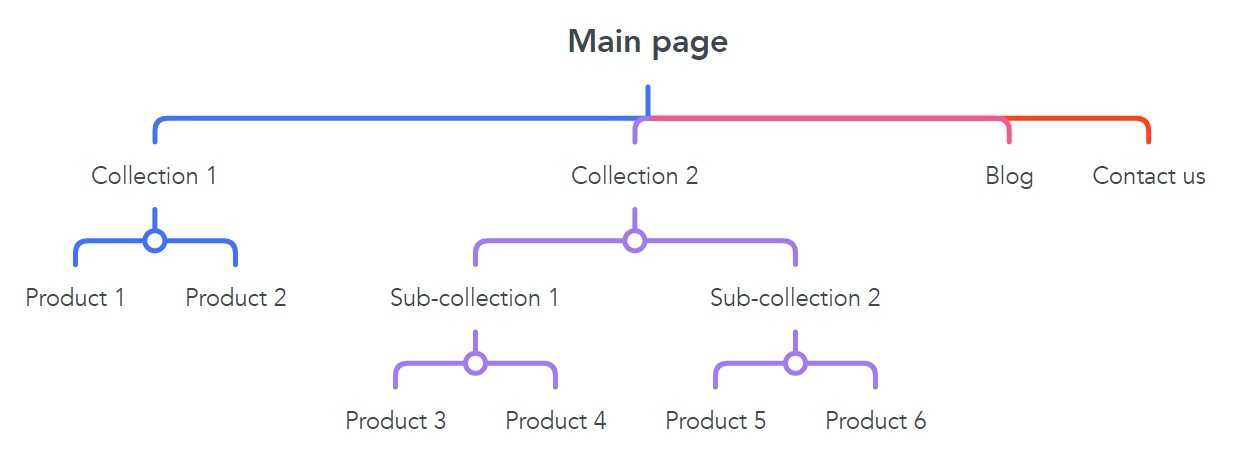
Shopify theme site structure is not only about navigation for your end-user. Proper technical structuring helps Google index your store pages better. Having structured your collections tightly, you have high chances to increase keyword relevance for each of your Collection pages and the outcome of SEO optimization of each of them for the keywords chosen will be more effective. Even if you don’t have many products, try your best to group them into at least two collections.
With regards to URL structuring for each single product webpage, the best structure to create is:
example.com/products/prada-casual-dress
Where “prada-casual-dress” is the user-friendly name of your product, containing keywords whenever possible, and not too long to not look spammy. It is also very important that your Collection pages contain links to direct product pages and not ones embedded into the collection structure. An example of the wrong product link inside a collection will be:
example.com/collections/dresses-for-sale/products/ prada-casual-dress
Shopify has also created a useful guide on how to structure online store menus and categorize subpages. The platform owners also emphasize the importance of creating and maintaining separate product web pages for every product variant. An example of such a case is having separate pages for different colors of the same product.
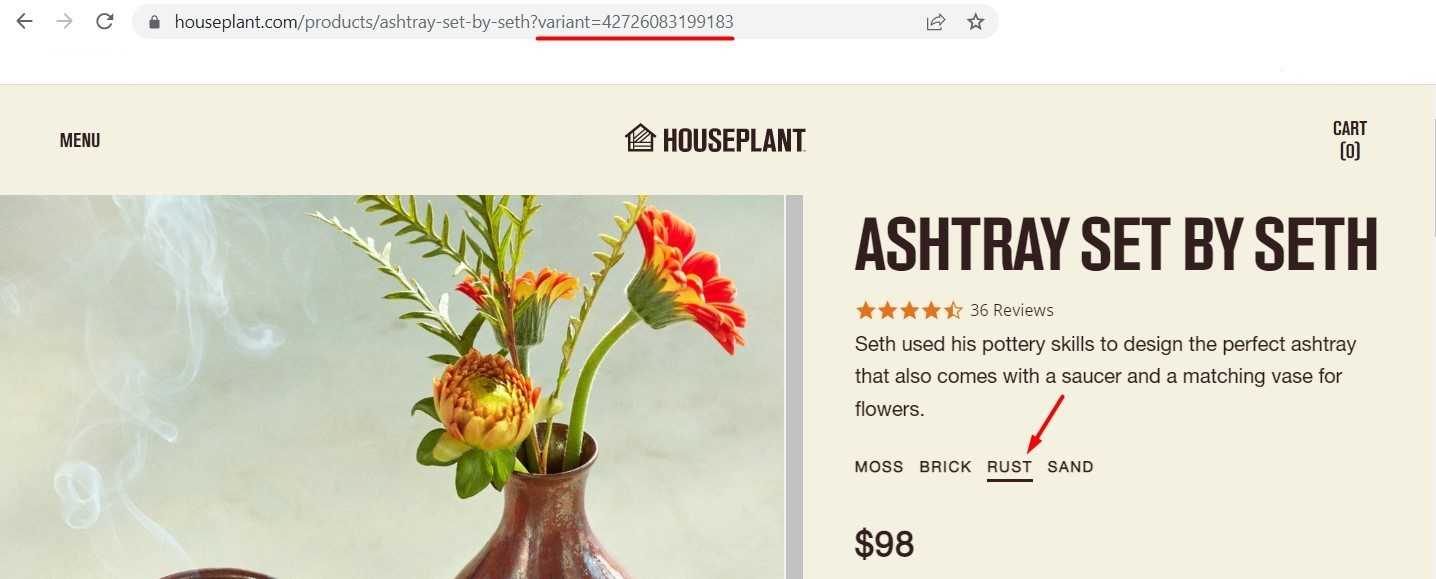
While Shopify recommends achieving using a parametrized URL as shown below, using autogenerated pages with varian codes will result in duplicated content:
example.com/products/prada-casual-dress?variant=t42078912
Moreover, the default setting for such pages is a canonical link resulting in no-index.

So, we recommend creating a new product page instead, for each color, size, or other variant.
On-page optimization
For each of your webpage types (home page, collection pages, product pages, and other pages such as blog posts), you need to do on-page optimization separately. Follow the steps described below.
Home page
For your home page, always:
create a unique domain name, possibly with core keywords you gathered during your research. These should correspond to the chosen niche and characterize the focus of your business and the main search intent;
include SEO title and SEO description, with a high density of keywords but still natural language for readability;
use h1 and h2 headings;
generate unique selling content and add proper keywords;
add SEO-optimized images and schema markup, which will be well explained below.
Collection pages
Always remember to consider a collection page as a navigation tool, or category page, so remember to use collections to group products for your end user’s ultimate sake. For each of your collection pages, do:
determine keywords of the collection itself and use them for both URL and metadata (SEO title and SEO description);
set up correct pagination to avoid duplicated content indexed badly - to be explained later on in this article;
create tags/categories for better filtering. Mind having several levels of categories, i.e. subcategories;
add unique content including keywords.
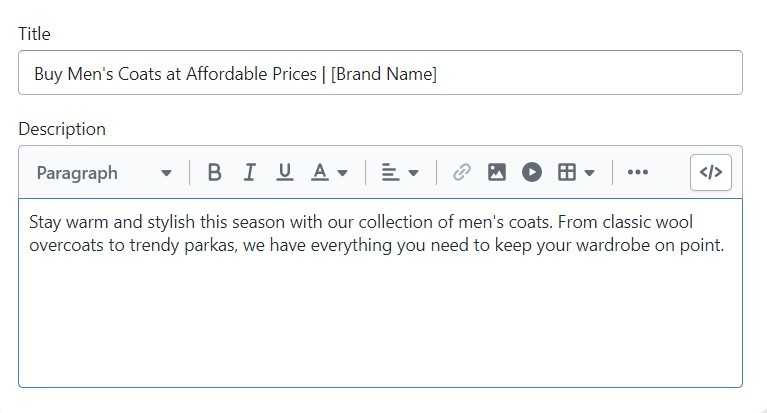
Product pages
Product pages and their unique product URL structures are the main sellables of your Shopify store and also the main indexed searchable units. Go from each collection down when deciding what product page to create and what content to include. Create a separate webpage for each possible option of the same product and generate a unique description for it. Work carefully with the keywords you gathered before, to generate the URL, page title, and page description, and to optimize the main product image (details of image SEO optimization to be described below).
Other pages
On Shopify, “other pages” usually refer to the blog post pages which can be created for any useful information you can offer. Write and publish articles regularly, including keywords you prepared and interlinking carefully with your collection and product pages. You can announce discounts and campaigns via blog posts, or publish collection releases. This is a nice way to get a boost for a certain category or a product tag once in a while.
Ideas of other pages to create are: About Us (include your qualifications), Contact Us (include physical location address and ways to contact you to get a quick response; having a map and working phone numbers will be a plus), F.A.Q. (mind explaining major details of your product usage and answering most frequent questions asked), Product Reviews (use keywords in each review!), Terms of Service, Delivery Terms, Return Policy, Disclaimer, etc.
Remove duplicate content
One of the most serious cons of the Shopify platform is the automatic creation of duplicate content which spoils your SEO efforts. So, after you have optimized all your webpage types, it is important to go and remove all duplicate content that was generated.
The main potential problem with duplicate pages and duplicate collection content in e-com stores traditionally and on Shopify is that there can be different collections linking the same products, or similar product webpages for different product variants where more or less the same content is published. This usually happens because e-com platforms allow the creation of tags and filters, and such pages get dynamically generated URLs with non-unique content. Ultimately, we, of course, want only one unique page per each collection and per each product, so canonicals can be used. So, pagination and tagging in Shopify should better be taken under control.
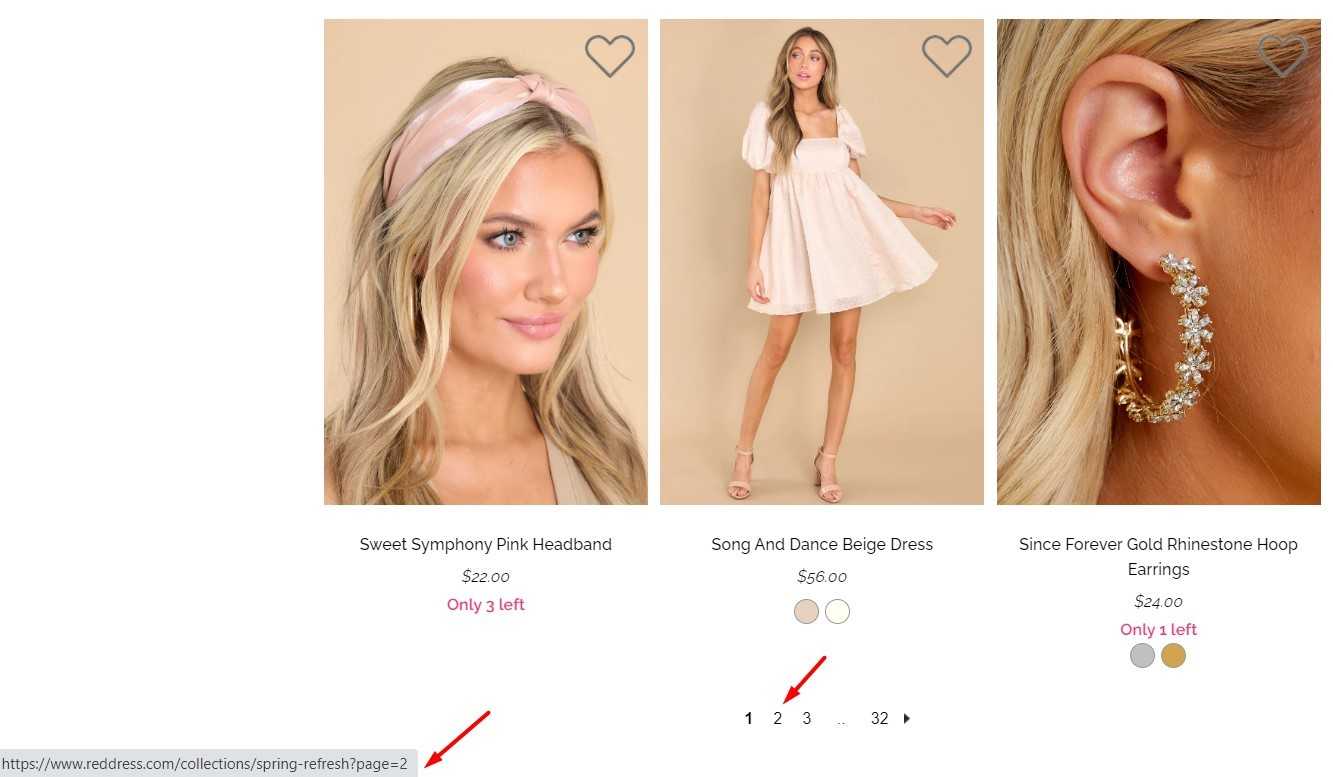

The above example demonstrates that pagination webpages are open for indexation, which results in as many as 31-page duplicates.
In our past blog posts, we have discussed how dangerous pagination can be for SEO because different pages have the same URL, keywords, and content, and reduce your optimization efforts due to duplication. On Shopify, paginated pages are set up by default, so you need to be aware of that and re-configure your store site early enough. This is especially related in case you have large product collections. The three options to configure Shopify pagination are:
To avoid dealing with pagination causing duplicated content, enable auto-load of the next products on the collection page. To enable this approach called “United page”, you need to create some custom code that will do your pagination on the same webpage allowing your user to click the “load more products” button and/or enabling an endless scroll.
For pagination pages left, set up the canonical tag. For example, the second page with URL example.com/collection/casual-dress?page=2 needs <link rel="canonical" href="https://example.com/collection..." />. The same should be done for pages number 3, 4, etc.
For tag pages, set up the canonical tag and the noindex tag. To do that wisely, combine using a noindex tag for each paginated page and a canonical link to the main collection page. Although Google says this is not allowed to combine together, practice shows there is no negative effect of using this approach, while there are obvious advantages of removing duplicated content.
Image optimization
Image SEO optimization remains crucial on Shopify as everywhere else. We discussed image ranking previously, and these tips can be useful here, too. The main issue about Shopify is that you can add numerous metadata to an image, from keyword to location, but it all will be stripped out during the image upload.
The key parameters to check when doing image optimization for Shopify are:
Having truly unique images. A nice life hack here is to crop images you download from photo stock websites or your supplier photo collection, put a watermark, or do other changes to each photo. Mind putting a uniform layout everywhere to make your store look stylish and nice through standardization;
Having proper sizes of the images. Resizing is important to ensure coverage of all types of devices. Smaller images have poorer quality but are faster to load. Compressing images wisely without losing the visual quality of the content can be well done using this tool;
Configuring good file names. Mind including all necessary words to describe your product as well as keywords that the users search it with;
Setting up alt tags. This is classic of image alt text Shopify SEO. Never leave this field empty, as it increases the relevance of the image for Google. The best way to fill in the alt tag is to describe what is actually displayed on the photo.
Schema markup
Another opportunity to do more of on-page optimization is Shopify schema markup, which is SEO-friendly structured data. Schema-dot-org reminds us about the nature and the purpose of this tool. In Shopify settings, schema markup is available for the following page types: product page, collection page, category page, and also the home page. It is recommended to remove the native schema code before manually adding your custom schema code.
Having finished your setup, feel free to validate its correctness via the corresponding Google schema testing tool.
Internal linking
Correct setup of internal links on collection pages can help improve the relevance of both product pages and collection pages considerably. This is why it is important to formulate correct anchors for each link and not to include “accidental products” in a collection.
Technical SEO
After you have finished your content preparation and basic SEO optimization, don’t forget to do the technical part: page speed optimization, preparing Robots.txt file and Sitemap.xml, setting up no-index for some pages, and connecting Google Search Console and Google Analytics.
Page speed
Shopify is not the fastest platform around. Mind applying page speed optimization tricks for pages with embedded video from YouTube or Vimeo? We recommend using a specific iFrame to embed the video so that the thumbnail is shown only and the video is not downloaded until someone actually clicks on it.
<iframe
width="560"
height="315"
src="https://www.youtube.com/embed/your_personal_link"
srcdoc="<style>*{padding:0;margin:0;overflow:hidden}html,body{height:100%}img,span{position:absolute;width:100%;top:0;bottom:0;margin:auto}span{height:1.5em;text-align:center;font:48px/1.5 sans-serif;color:white;text-shadow:0 0 0.5em black}</style><a href=https://www.youtube.com/embed/your_personal_link><img src=https://img.youtube.com/your_personal_link.jpg alt='your_personal_alt'><span>▶</span></a>"
frameborder="0"
allow="accelerometer; autoplay; encrypted-media; gyroscope; picture-in-picture"
allowfullscreen
title="your_personal_title_video"
></iframe>
This will allow increasing page speed from an average of 14 sec down to 5 sec or below.
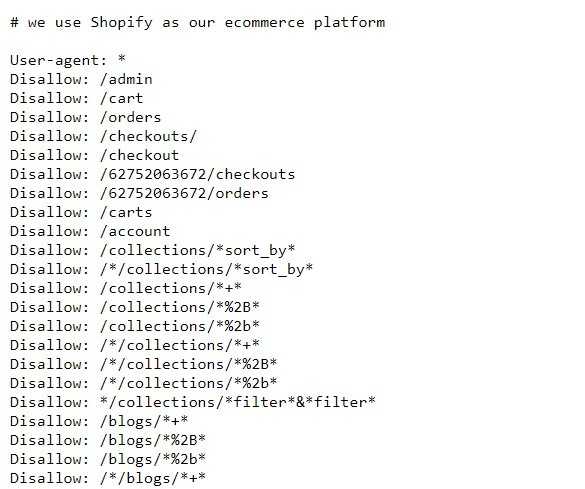
The below example of a default Shopify Robots.txt file demonstrates that it is good enough by default. Crawling is forbidden for the admin area, checkout page, shopping cart, order page, internal search, and policy pages. This Shopify’s native guide explains how to customize Robots.txt file via liquid code in case it is necessary for a store owner.
Sitemap.xml
By default, Shopify autogenerates its sitemap upon each new webpage creation or existing page updating, which can be found at example.com/sitemap.xml with links to the below-listed child sitemap types:
Sitemap_products_1.xml for the product webpages;
Sitemap_collections_1.xml for collection webpages;
Sitemap_blogs_1.xml for blog post entries.
There is no need to do a custom sitemap on Shopify as the below files are good enough for Google indexation. The only exception is when you need to exclude one or more pages from indexation. See the below section for an explanation of how to do that.
Noindex
While Shopify does not allow user-friendly configuring of no-index webpages, there is an available workaround to do that. Find the theme.liquid file and add the below custom code to it:
{% if template contains 'search' %}
<meta name="robots" content="noindex">
{% endif %}
Connect Google Search Console
There are two main SEO analytical integrations necessary to track your Shopify store optimization progress: Google Search Console and Google Analytics. To connect to Google Search Console, you need to follow below steps:
Log into Google Search Console
In the menu, chose “Add A Property”
Select URL Prefix as the Property Type
Type your canonical website property and click Continue
Choose the HTML verification method among the given options and copy the meta tag
Go back to your Shopify store -> Online Store -> Themes -> Actions -> Edit Code
In your theme.liquid, locate <head> and <body>.
Copy the code after <head> and before <body> and save.
Go back to Google Search Console and enjoyed a verified connection.
You can start by testing your sitemap, configuring International Targeting settings, and checking if there are any SEO issues needing your attention and fixing.
Connect Google Analytics
The second most important integration to track all your search engine optimization-related data is Google Analytics. To connect it to your Shopify store, you should go to the Google Analytics website using the same credentials you entered above, create a new account there, set it up for the “Web” option, fill in the store details (title and website home page URL), correct industry and timezone of your business, and click “Create.” Having agreed to the Service Agreement, you will be prompted to confirm your domain ownership via Google Analytics tagging. You should copy the offered text, go back to your Shopify Dashboard -> Preferences -> Google Analytics, paste it fully to the corresponding text field of your Google Analytics account, and click “Save.” Then you should go back to Google Analytics, go to Admin -> E-commerce setup, and tick both “Enable E-commerce” and “Enable Enhanced E-commerce Reporting.” Upon saving this setting, your Shopify account is fully enabled with Google Analytics.
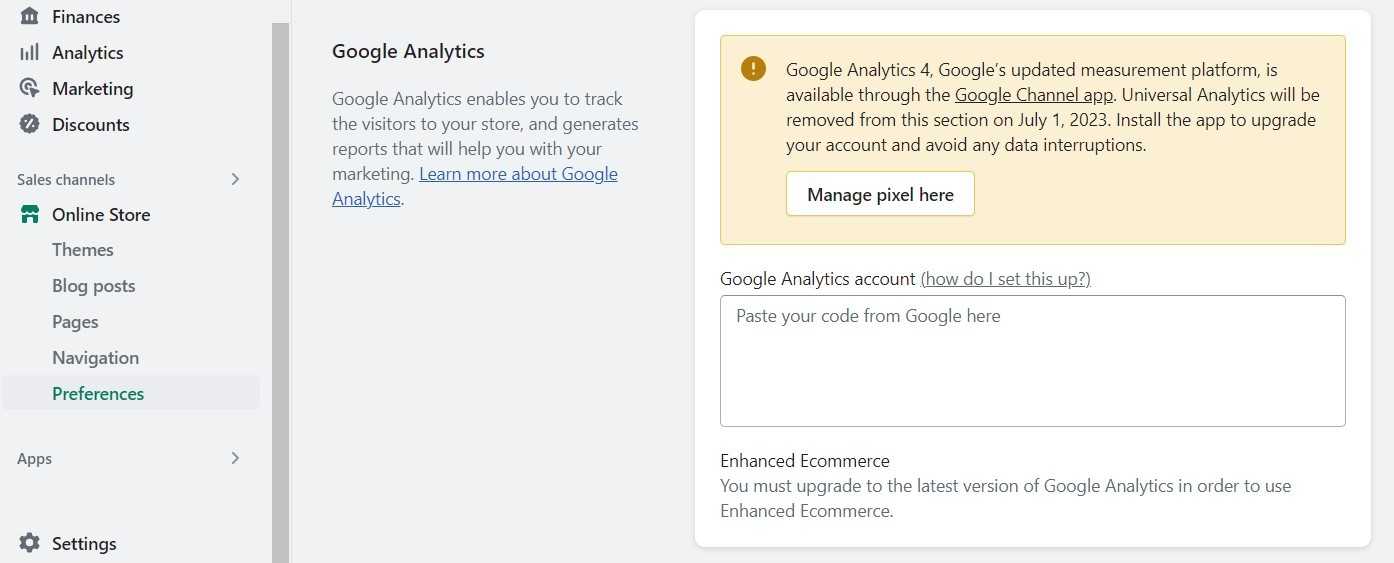
Blog promotion and link-building
So, each new blog post published should get enough backlinks in the next few days to support its visibility and the website's high ranking. Ideally, you should strive for as high a domain rank of your link placements as possible. A good example of having a high-quality backlink to each of your Shopify blog posts is to repost it on Medium, which we have recently written about. You can also use content plans and publish press releases.
And, of course, setting up paid promotions for your Shopify store and your blog entries in Google (via Google Ads) and on various social media platforms (Facebook, Instagram, YouTube, etc.) is a good idea, too. It will allow bringing more traffic to your new posts, generate new leads, and get fresh visitors to both boost your brand awareness and call for action such as sales.
Analysis
As with any other SEO activity, don’t forget to analyze your Shopify SEO visibility regularly. Recently, we have discussed how to choose SERP software properly. Using a good tool regularly will allow you to see if fine-tuning is needed for the pages created previously or any re-analysis and repeated keyword research. The SpySerp SEO Rank Tracker Tool can be helpful here to enable detailed rank tracking per keyword over a period of time with concrete volume numbers displayed daily. Such statistics can help you detect correlation with your SEO activities precisely enough to confirm or refute your SEO hypotheses.
Conclusion
In this article, we have discussed some tips and tricks for Shopify SEO optimization, considered creating separate product variant web pages, and discussed Shopify pagination examples, URL structures, and opportunities for schema markup. The on-page optimization section can truly be used as the Shopify SEO checklist.
Although this platform’s load speed is low, Shopify is too popular across the globe to ignore it. So, we recommend creating your e-com store site there and following the listed recommendations to increase its indexation and search visibility for the keywords gathered. Don’t forget that the same SEO principles are applicable here. Prepare useful content for the user, mind search intent, post regularly, and keep having high-quality content. This will ensure your SEO success.





